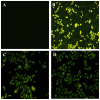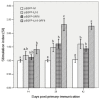Immune responses in pigs induced by recombinant DNA vaccine co-expressing swine IL-18 and membrane protein of porcine reproductive and respiratory syndrome virus
- PMID: 22754326
- PMCID: PMC3382812
- DOI: 10.3390/ijms13055715
Immune responses in pigs induced by recombinant DNA vaccine co-expressing swine IL-18 and membrane protein of porcine reproductive and respiratory syndrome virus
Abstract
In this study, two DNA vaccines, which express the membrane (M) protein of porcine respiratory and reproductive syndrome virus (PRRSV) (pEGFP-M) and co-express both M and swine IL-18 (pEGFP-IL18-M), were constructed and their abilities to induce humoral and cellular responses in piglets were comparatively evaluated. Experimental results showed that both recombinant DNA vaccines could not elicit neutralizing antibodies in the immunized piglets. However, both DNA vaccines elicited Th1-biased cellular immune responses. Notably, pigs immunized with the plasmid pEGFP-IL18-M developed significantly higher levels of IFN-γ and IL-2 production response and stronger specific T-lymphocyte proliferation response than the pigs inoculated with the plasmids pEGFP-M and pEGFP-IL18 (P < 0.05). These results illustrated that co-expression of M and IL-18 proteins could significantly improve the potency of DNA vaccination on the activation of vaccine-induced virus-specific cell-mediated immune responses in pigs, which may be used as a strategy to develop a new generation of vaccines against highly pathogenic PRRSV.
Keywords: DNA vaccine; IL-18; M protein; PRRS; immune response.
Figures






Similar articles
-
Porcine GPX1 enhances GP5-based DNA vaccination against porcine reproductive and respiratory syndrome virus.Vet Immunol Immunopathol. 2017 Jan;183:31-39. doi: 10.1016/j.vetimm.2016.12.001. Epub 2016 Dec 6. Vet Immunol Immunopathol. 2017. PMID: 28063474
-
Evaluation of a DNA vaccine candidate co-expressing GP3 and GP5 of porcine reproductive and respiratory syndrome virus (PRRSV) with interferon α/γ in immediate and long-lasting protection against HP-PRRSV challenge.Virus Genes. 2012 Dec;45(3):474-87. doi: 10.1007/s11262-012-0790-1. Epub 2012 Jul 28. Virus Genes. 2012. PMID: 22843314
-
Enhanced immune responses in pigs by DNA vaccine coexpressing GP3 and GP5 of European type porcine reproductive and respiratory syndrome virus.J Virol Methods. 2014 Sep;206:27-37. doi: 10.1016/j.jviromet.2014.05.021. Epub 2014 May 29. J Virol Methods. 2014. PMID: 24882496
-
Innate and adaptive immunity against Porcine Reproductive and Respiratory Syndrome Virus.Vet Immunol Immunopathol. 2015 Sep 15;167(1-2):1-14. doi: 10.1016/j.vetimm.2015.07.003. Epub 2015 Jul 17. Vet Immunol Immunopathol. 2015. PMID: 26209116 Free PMC article. Review.
-
Multi-epitope vaccines: a promising strategy against viral diseases in swine.Front Cell Infect Microbiol. 2024 Dec 20;14:1497580. doi: 10.3389/fcimb.2024.1497580. eCollection 2024. Front Cell Infect Microbiol. 2024. PMID: 39760092 Free PMC article. Review.
Cited by
-
Phenotypic Characterization of Porcine IFNγ-Producing Lymphocytes in Porcine Reproductive and Respiratory Syndrome Virus Vaccinated and Challenged Pigs.Virol Sin. 2018 Dec;33(6):524-530. doi: 10.1007/s12250-018-0073-7. Epub 2018 Dec 17. Virol Sin. 2018. PMID: 30560415 Free PMC article.
-
In vitro evaluation of the antiviral activity of the synthetic epigallocatechin gallate analog-epigallocatechin gallate (EGCG) palmitate against porcine reproductive and respiratory syndrome virus.Viruses. 2014 Feb 21;6(2):938-50. doi: 10.3390/v6020938. Viruses. 2014. PMID: 24566281 Free PMC article.
-
Co-Formulation of Recombinant Porcine IL-18 Enhances the Onset of Immune Response in a New Lawsonia intracellularis Vaccine.Vaccines (Basel). 2023 Nov 30;11(12):1788. doi: 10.3390/vaccines11121788. Vaccines (Basel). 2023. PMID: 38140192 Free PMC article.
-
Evaluation of Different DNA Vaccines against Porcine Reproductive and Respiratory Syndrome (PRRS) in Pigs.Vaccines (Basel). 2013 Oct 18;1(4):463-80. doi: 10.3390/vaccines1040463. Vaccines (Basel). 2013. PMID: 26344342 Free PMC article.
-
RNA interference targeting nucleocapsid protein inhibits porcine reproductive and respiratory syndrome virus replication in Marc-145 cells.J Microbiol. 2014 Apr;52(4):333-9. doi: 10.1007/s12275-014-3419-3. Epub 2014 Mar 29. J Microbiol. 2014. PMID: 24682995 Free PMC article.
References
-
- Guo B.Q., Chen Z.S., Liu W.X., Cui Y.Z. Isolation and identification of porcine reproductive and respiratory syndrome (PRRS) virus from aborted fetuses suspected of PRRS (in Chinese) Chin. J. Anim. Poult. Infect. Dis. 1996;2:1–5.
-
- Wu J., Li J., Tian F., Ren S., Yu M., Chen J., Lan Z., Zhang X., Yoo D., Wang J. Genetic variation and pathogenicity of highly virulent porcine reproductive and respiratory syndrome virus emerging in China. Arch. Virol. 2009;154:1589–1597. - PubMed
-
- Snijder E.J., Meulenberg J.J.M. The molecular biology of arteriviruses. J. Gen. Virol. 1998;79:961–979. - PubMed
Publication types
MeSH terms
Substances
LinkOut - more resources
Full Text Sources
Miscellaneous

